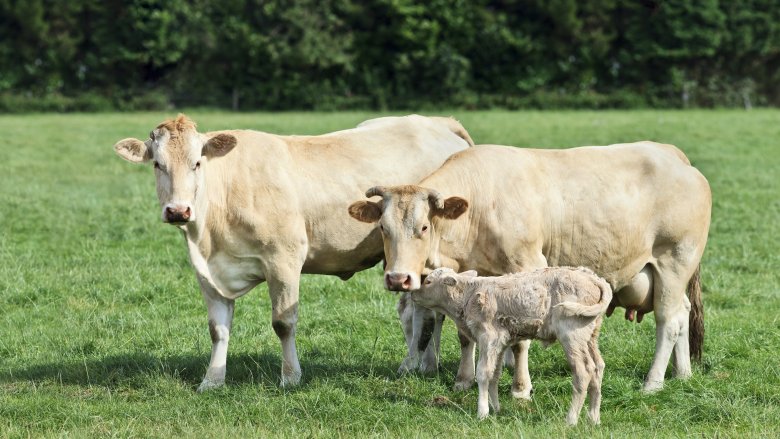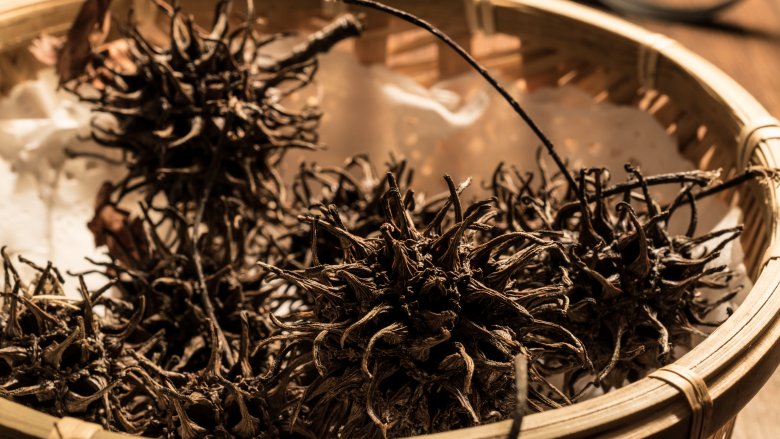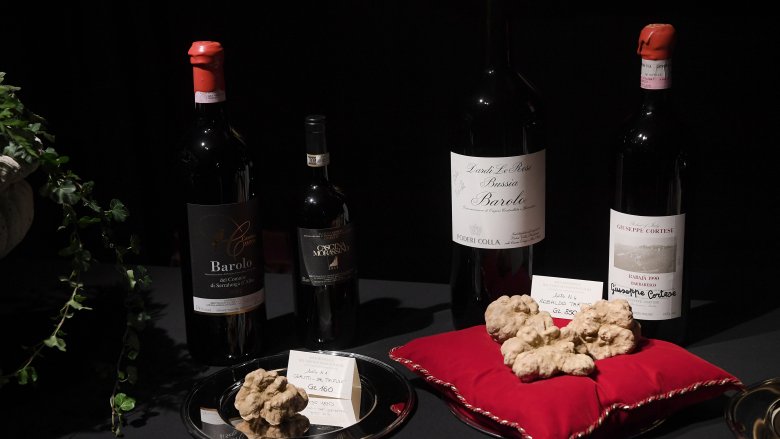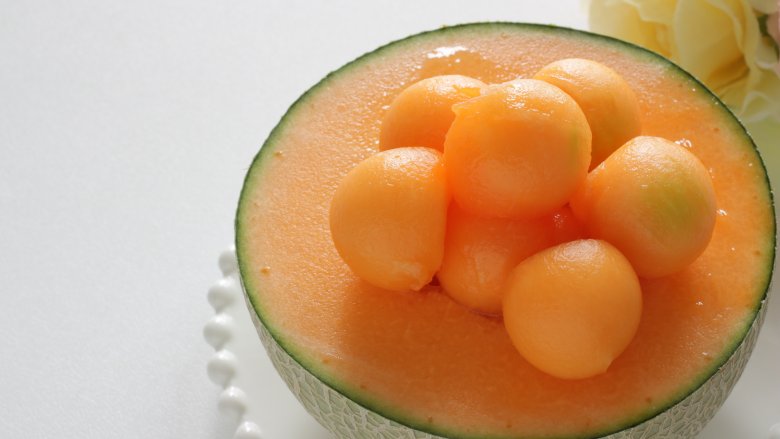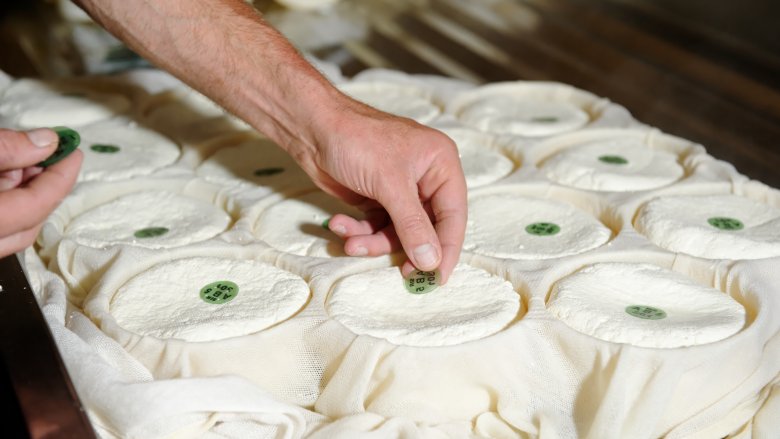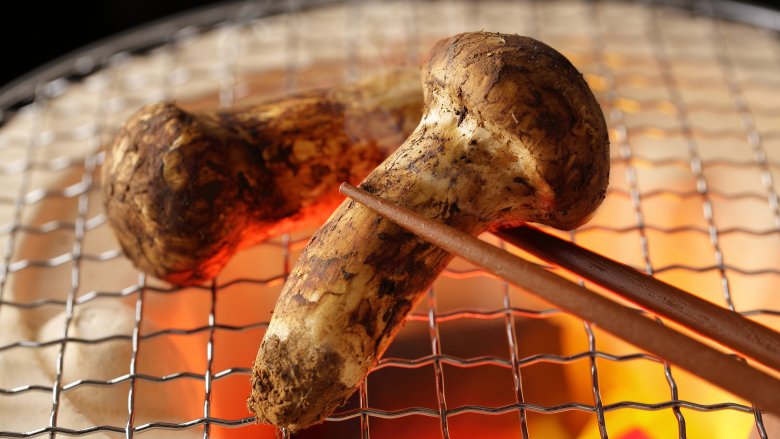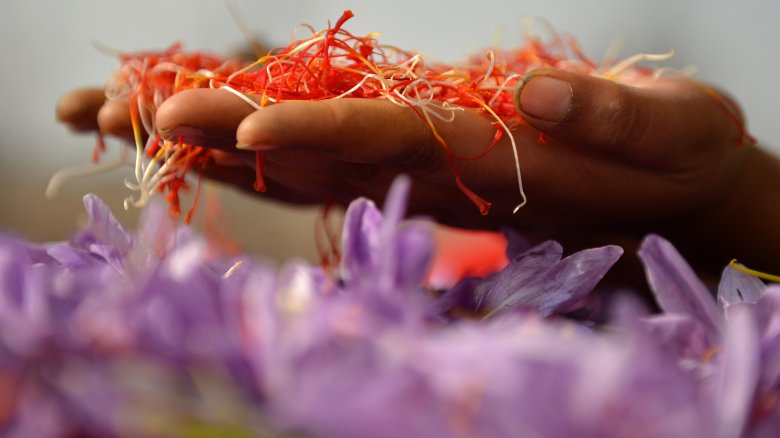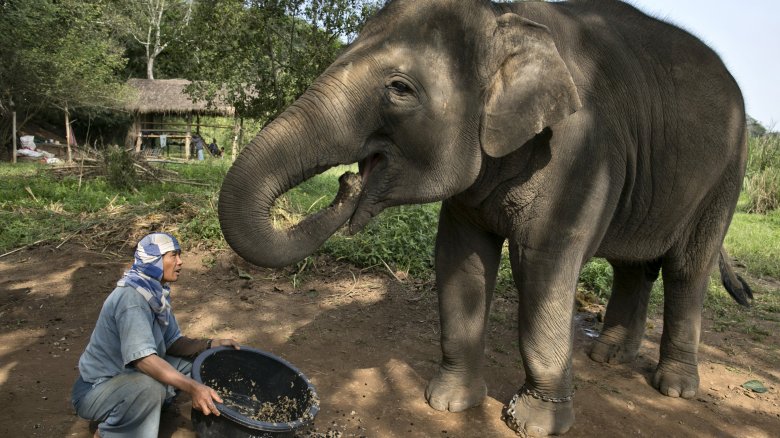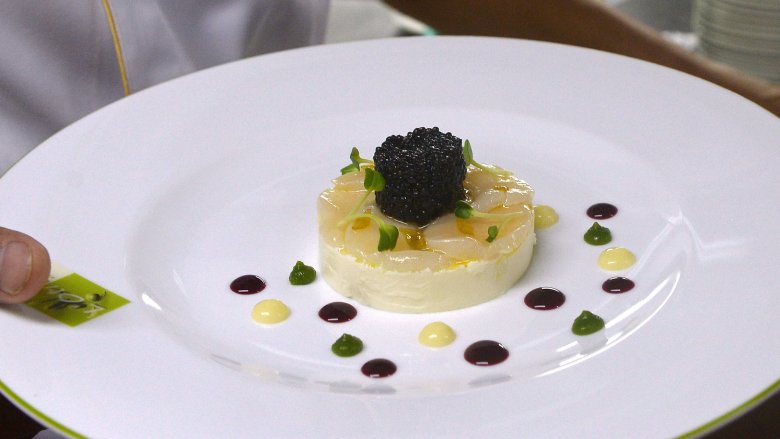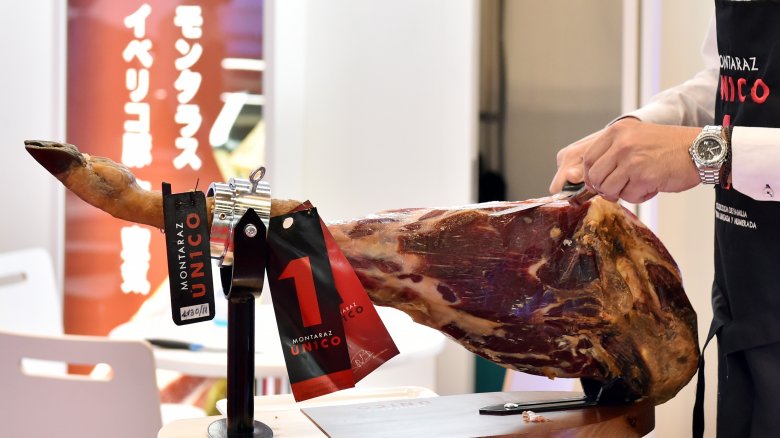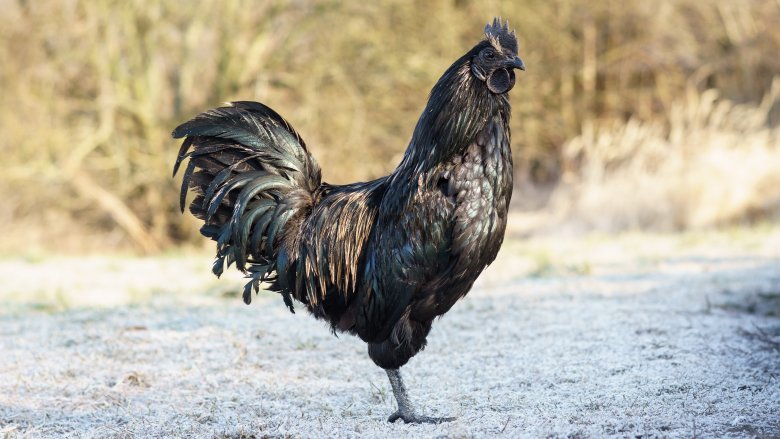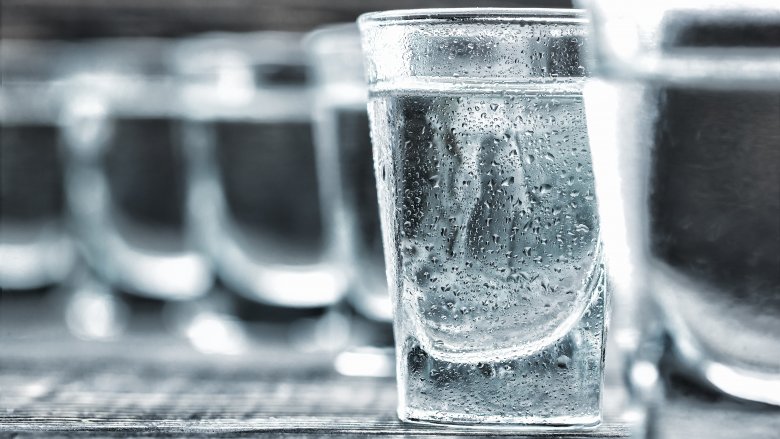Most Valuable Foods On The Planet
For most of us, the idea of forking over a little extra cash for an expensive food means things like picking up a special bag of coffee or splurging on a pint of ice cream... even though it's not on sale. The 21st century food world is a balancing act: we'd love to be able to make every recipe we see pop up on social media and make them picture perfect, but sometimes, it's just not in the budget. That's why stores like Aldi and Lidl are taking the world by storm, after all: There's a lot to be said for getting good food at affordable prices.
We're here to talk about the other side of the gold coin, as it were. For some people, the price tag on something just doesn't matter. For others, the higher the price, the higher the status symbol that goes along with it. That's true of everything from cars to food, so let's talk about some insanely expensive, highly valuable foods you might never buy.
Blonde Aquitaine hibernated steaks
Move over, Wagyu beef, there's a new steak in town. According to the Robb Report, the most expensive steak in the world costs a whopping $3,200. It's a 15-year rib steak that's only served in a few places, including Guy Savoy's Paris restaurant and Fabrice Vulin's Caprice restaurant in Hong Kong. There, ordering a 2-pound steak tacks a staggering $4,000 on to the bill.
What makes it so valuable? CNN went straight to the source: the Polmard Eleveur Boucher butcher shop in Paris. The family-owned business has been handed down for generations, and in 1990 they developed a method of treating their meats they call hibernation. Meat is exposed to blowing air around -45 degrees Fahrenheit, and they say it perfectly preserves the meat indefinitely with no degradation. The cows are special, too. They're Blonde Aquitaine cows raised in the countryside of northern France, where the Polmard family says they're treated to five-star accommodations and a stress-free life... right up until their end in a specially-designed, stress-free slaughterhouse. That lack of stress supposedly reduces the lactic acid that ends up in the meat, making these cows super tender and flavorful. But is it $3,200 worth of flavor?
Da Hong Pao
There are thousands of different types of tea in the world, and it's a drink with an impressively long history. According to the BBC, one of the most valuable types of tea costs way more than you might expect: It's worth about 30 times its weight in gold. A single gram of the original type of Da Hong Pao tea costs about $1,400, and that means a single pot of tea is going to set you back around $10,000.
There's actually a very good reason for how expensive that single pot of tea is (and to clarify, there's plenty of Da Hong Pao teas that are decently affordable, we're talking about the original here). Da Hong Pao teas come from a staggeringly beautiful area of southern China, and get their distinctive flavor in part from the rain that waters the plants after running through a limestone landscape. All Da Hong Pao tea trees trace their lineage back to a single group of trees: the mother trees. The tea from those mother trees is the expensive stuff, and since there aren't too many left (it's just one of the many things the Earth is running out of), it's only going to get pricier.
White truffles
The price of white truffles varies — a lot — and The Telegraph says a huge part of the fluctuation is based on the Italian climate and, in turn, how good the year's harvest is. In 2017, the price was up to $5,500 a kilo, almost double what it was the prior year, thanks to scarcity. Those are just restaurant-grade truffles, and sometimes, lucky truffle hunters stumble across something even better.
In 2012, CBS News reported a single truffle, weighing in at around 2 pounds, sold for $330,000 in a 2010 auction. Part of the reason for the consistently high price is they have to be found rather than grown, and they're one of the few food crops that have consistently refused to be domesticated. In the towns that rely on the truffle crop, they're so revered that Church masses are even said in their honor. On the flip side, there's also a pretty shady industry growing up based around truffles. They're often stolen and sold, farmers are harassed, and the most successful truffle-hunting dogs are at risk of being stolen, too. All over a fungus.
Yubari King melons (and other luxury fruit)
The Yubari King is a type of melon — specifically, it's a cross-breed created from two different types of cantaloupe — that's native to the Yubari region of Japan. In 2017, the Independent reported a perfect pair of melons had just sold for $30,300, and if you think that's insane, buckle up. We're just getting started.
While less perfect melons might sell for considerably less (but still a lot), that's just one part of Japan's obsession with perfect fruit. CNN says high-end fruits aren't just fruit, they're luxury items, honored gifts, and status symbols. Creating the perfectly shaped, flavored, and textured fruit is incredibly labor-intensive, and it's reflected in the prices.
Perfect Bijin-hime strawberries are about the size of a tennis ball, and typically sell for around $4,000 each. Bunches of Ruby Roman grapes usually go for around $880 a bunch, although the record-setter there was a single bunch for $9,700. That works out to around $320 a grape.
Pule: Donkey cheese
Pule is a donkey cheese that doesn't just come from any old donkey, it comes from the milk of the rare Balkan donkeys of Serbian. Atlas Obscura says a single pound of cheese will run you around $1,700, and that high price comes because donkeys don't give a lot of milk, and it also takes a lot more donkey milk to make cheese than, say, goat or cow's milk. (One donkey can produce enough milk for about four pounds of cheese a year.) The donkeys are milked three times a day by hand, and this hefty price tag has an excellent cause behind it: saving the endangered donkeys.
According to NPR, most of the pule donkey cheese that's on the market comes from the donkeys of the Zasavica nature reserve. It was started around 1997, when lawyer-turned-farmer Slobodan Simic started saving donkeys no one else wanted. He moved them to the reserve, started caring for them, and it's now the biggest donkey farm in eastern Europe. He uses the proceeds from the cheese to support the reserve and the donkeys who live there, and that's a cause we can all get behind.
Matsutake mushrooms
The Los Angeles Times calls Kicho one of the world's most exclusive restaurants, and it's so exclusive the only way you can get a reservation is to be introduced by someone who's already been there. Once you're in the door, expect a meal to run you at least $800, and according to the restaurant's owner, a lot of that cost is tied up in the matsutake mushroom.
A whole, single mushroom costs around $80, and the stem alone is worth around $40. They're not even huge mushrooms, either, only a few inches tall. Part of the price tag comes because they — like the even pricer white truffle — haven't been domesticated yet. They're only able to be found and picked during a short season of a few weeks in autumn, and it's made even more rare by the fact that ever-increasing urbanization is destroying Japan's wilderness — the only place these little guys grow.
Saffron
When it comes to spices, saffron still reigns as the most expensive in the world. According to The Telegraph, high-quality Spanish saffron costs around $7.30 a gram. Doesn't sound like much? That means a pound of the stuff will set you back around $3,300.
There are a few good reasons for that high price. It takes anywhere from 70,000 to 250,000 flowers to make that same pound of saffron, and it can only be harvested by hand. (Awesomely, ancient murals from Crete show what seems to be a monkey trained to harvest saffron, and we have no idea why that hasn't continued.) Crops only yield their full potential every three years, and that means you're forking over a mint.
Saffron has been highly prized since ancient times, and it's been used as medicine in southern Europe, dye in India, and was smuggled into western Europe by pilgrims and Crusaders alike. Some tastes stay the same for centuries.
Black Ivory Coffee
Back in the old days — around 2012 — people were shocked by the price of coffee made from beans that had passed through the digestive tract of a cat called the kopi luwak. It wasn't just the fact it was cat poop coffee, it was the fact it was expensive. NPR says you could get a cup for around $10 and at the time, 4 ounces of beans would set you back around $60.
That's nothing compared to elephant poop coffee.
Fast forward two years, and NPR was talking about Black Ivory Coffee. This one's made from beans that have been fed to (then passed through) an elephant, and founder Blake Dinkin says the process is hugely important — and has more of an impact on the final product than the cat ever did. Since elephants are herbivores, there's a completely different taste to the coffee. NPR tried a $70 cup of elephant poop coffee (and came to the verdict that it tastes a bit nutty), and you can order some on the company's official website, too. How expensive are we talking? Around $1,000 a pound.
Strottarga Bianco caviar
Caviar already has something of a reputation as the food of the rich and famous, but even so, the caviar dubbed "white gold" is in a category of its own. Strottarga Bianco is the roe of a rare fish — the albino sturgeon — and it's only available through special order. Anyone able to fork over the $113,600 per kilo isn't just going to get pure fish eggs, as it comes sprinkled with 22 carat gold leaf.
White gold. Get it?
The caviar was created by Austrian fish farmers in 2015, and CNBC quoted company founder Walter Grull as saying they did it because "the market is crying out for new and absolutely exquisite products that chefs around the world can offer their guests." And, if you're wondering just how much of that cost comes from the gold and how much from the caviar itself, you can buy gold-free white caviar for only about $28,400 a kilo. So, what the heck would you put it on once you got it? They recommend toast.
Jamon iberico
Ham is a pretty standard protein, but if you want something extra-special you can spring for a leg of jamon iberico. That will set you back a cool $2,500, says The Guardian, and those are some crazily expensive sandwiches.
Medium took a look at just why this particular kind of ham is so darn expensive, and they say it's all in how they're raised. Jamon iberico is made only from the black-hoofed Iberian pigs, and in order to be official, they spend the last winter of their lives living free-range and eating only acorns.
There's a ton of history here, too. In 77 AD, Pliny even wrote about how delicious these particular pigs are, and a few centuries later, they fed the crew of Christopher Columbus's ships. They traveled with other explorers, crossed the ocean a few times, and that pretty much means you're eating a slice of history, which is presumably included in the price.
Ayam cemani chickens
Ayam cemani chickens might be the coolest-looking chickens on the block, but you're going to pay a pretty penny for adding a few of these birds to your flock. According to Ozy, asking prices hover around $2,500 per bird, and it's not just because of their good looks.
The chickens are completely black, and by that, we do mean completely. Their feathers, skin, meat, and claws are black, and so are their bones, organs, and — some say — blood. (That's up for debate, others claim it's just dark red.) There are a ton of beliefs that have developed around the birds, which have been popular across Asia for at least 800 years. Thought to be high in iron, they're particularly popular as a meal for women who have just given birth. They're thought to convey all kinds of health benefits to those who eat them, along with good luck and a clear conscience. They've become an integral part of religious ceremonies, too, and one thing's for sure: this chicken gives buyers a pretty big bang for their buck.
Billionaire vodka
Ever wonder what people drink when they're sitting at the top of the food chain? A fine scotch or whiskey, perhaps? Likely, but they also might be drinking something a little more valuable — like Billionaire Vodka. It doesn't cost exactly a billion dollars — a mere $3.75 million — and let's be honest, you just paused at that, right?
Sure, your brain hurts a bit now, but here's what you get for your millions: vodka with its own Billionaires Card concierge service, and a beverage made from natural spring water sourced from England and reportedly imbued with some healing qualities. The vodka itself is filtered through Nordic birch charcoal and sand — but not any ordinary sand, we're talking about sand that's made from crushed diamonds and other precious gems. It's then packaged up in a diamond-encrusted bottle, and it's hand-delivered by an armed courier. How else would you spend $3.75 million? If you can't think of any other options, don't worry: all the information you need to complete your bank transfer is conveniently listed on on their site.
